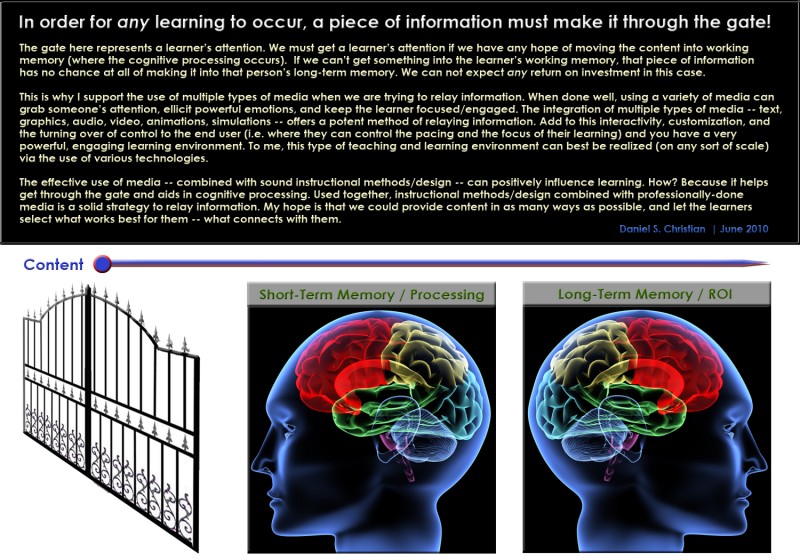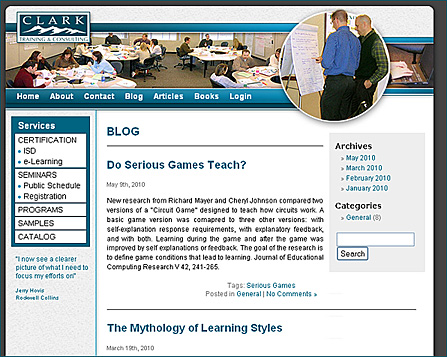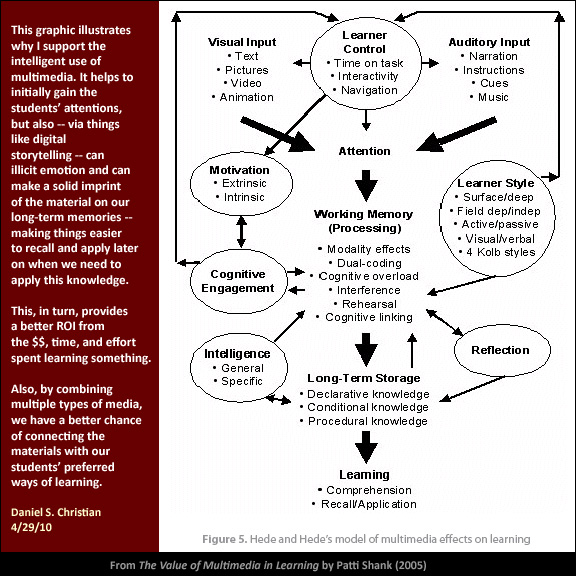20 facts you must know about working memory — from The E-Learning Coach
Excerpt:
The Basics
- Working memory used to be called short-term memory. It was redefined to focus on its functionality rather than its duration.
- Working memory can be thought of as the equivalent of being mentally online. It refers to the temporary workspace where we manipulate and process information.
- No one physical location in the brain appears to be responsible for creating the capacity of working memory. But several parts of the brain seem to contribute to this cognitive structure.
- Working memory is characterized by a small capacity. It can hold around four elements of new information at one time.
- Because learning experiences typically involve new information, the capacity of working memory makes it difficult to assimilate more than around four bits of information simultaneously.
- …
Capacity
I just listened to a presentation by Dr. Ruth Clark entitled, “Efficiency in Learning: Applying Cognitive Load Theory to Distance Learning”. Below are my notes from her presentation.
Besides our long-term memory we have a working memory — which is where the action is and where cognitive load theory focuses
- 7 +- 2 chunks
- George Miller’s work in the 1950’s re: the limitations of working memory
- Cognitive load theory is an update to George’s work
- The concept of “chunking” and the capacity of short term memory. Miller (1956) presented the idea that short-term memory could only hold 5-9 chunks of information (seven plus or minus two) where a chunk is any meaningful unit. A chunk could refer to digits, words, chess positions, or people’s faces. The concept of chunking and the limited capacity of short term memory became a basic element of all subsequent theories of memory.
- So segmenting of content is good – chunking it up — as information should be presented in small digestible units
- A digestible unit of information contains no more than nine separate items of information.
- By chunking information the author improves the reader’s comprehension and ability to access and retrieve the information.
- [Search for items related to “Information Processing Theory” and George Miller for more information]
- Working memory has a limited capacity
- Great for processing – not great for holding information
- Prior knowledge is key here
- Gets slower as trying to hold more information in working memory
- Our challenge as instructional designers is how to optimize cognitive load that maximizes learning
- More complex/difficult subject matter or more novice the learning à more cognitive load
- Intrinsic (imposed by content; how complex is the content?) + Extraneous / Extrinsic (irrelevant & want to minimize this) + Germaine (good stuff; relevant; want to maximize this)
- Intrinsic + extraneous + germaine = additive cognitive load
- Giving learners orientation gives better learning; establish context
- Use audio to explain visuals when appropriate – uses both auditory information track and visual information track
- Modality effect
- Better learning if a visual is explained by words expressed in audio (except if different language)
- Redundancy effect
- Don’t want to use the same text w/ same audio at the same time – less is more – if have a picture of something, with text next to it, plus having someone say that text is too much info – too much cognitive load
- Proximity effect
- Placement of text and visuals
- Keep visuals next to the relevant text/explanation of that visual
- Avoid splitting attention
- Germaine load
- Use examples – but also add self-explanation questions to examples to encourage deeper mental processing and not blowing the example off
- Some more tips
- Watch the pacing of the presented materials
- Provide control to user
- Don’t put items on screen unless serving a purpose
- Don’t put background music if trying to concentrate on learning something
- Motion – careful when use it
- If dealing with experts, don’t have to worry as much about cognitive load burdens; allow control/freedom
- Didn’t sound like Ruth supported learning styles too much – believes that we place too much emphasis on them; prior knowledge is the key according to Ruth
- Some synchronous, web-based communication and collaboration tools can cause cognitive overloads – as the interface can split our attention. We try to absorb information that is flowing at us from the various areas of the interface:
- Chat
- An attendee list of members
- The presentation area/PPTs
- Audio
- Motion w/ application sharing
- etc.
Clark Training & Consulting’s blog –> http://clarktraining.com/blog/
Thinking out loud about Connectivism — from iterating toward openness by David Wiley
The first part of commentary from David:
I’ve been reading George’s writing on the unique ideas in connectivism. Two assertions leap out at me in his list of how connectivism is different from other approaches.
First is the statement that “the same structure of learning that creates neural connections can be found in how we link ideas and in how we connect to people and information sources (emphasis DSC). One scepter to rule them all.”
This sounds almost exactly like the claim made in John Anderson and Lael Schooler’s 1991 Reflections of the Environment in Memory, which I consider one of the finest pieces of research in our field:
Availability of human memories for specific items shows reliable relationships to frequency, recency, and pattern of prior exposures to the item. These relationships have defied a systematic theoretical treatment. A number of environmental sources (New York Times, parental speech, electronic mail) are examined to show that the probability that a memory will be needed also shows reliable relationships to frequency, recency, and pattern of prior exposures. Moreover, the environmental relationships are the same as the memory relationships. It is argued that human memory has the form it does because it is adapted to these environmental relationships. Models for both the environment and human memory are described. Among the memory phenomena addressed are the practice function, the retention function, the effect of spacing of practice, and the relationship between degree of practice and retention.
From DSC:
David’s posting, George’s posting entitled, “What is the unique idea in Connectivism?”, and the comments therein create in my mind the image of a living, ever-changing, learning ecosystem…full of “nodes” that come into (and may eventually be removed from) our learning environment / sources of information.
Also from #CCK09 First Paper (Draft): ‘Positioning’ Connectivism, here are some more references regarding connectivism:
- Stephen Downes, A quick introduction to connectivism(ustream)
- Rita Kop & Adrian Hill, Connectivism: Learning theory of the future or vestige of the past?
- Marshall McLuhan, Understanding Media, 1964 (2006)
- George Siemens, Connectivism: A Learning Theory for the Digital Age
- George Siemens, Defining Connectivism and Comparing connectivism with other learning theories
- George Siemens, What is the unique idea in Connectivism?
- Plon Verhagen, Connectivism: A New Learning Theory?
Three Generations of Distance Education Pedagogy
Facilitator: Dr. Terry Anderson
Institution: Athabasca University
Date and time: Apr 14, 2010 11:00 AM
In this presentation Terry defines three pedagogical models that have defined distance education programming – behavioural/cognitive, constructivist and connectivist. He talks about the challenges and opportunity afforded by each model, with a focus on the emergent development of connectivism.
Expanding on the Nine Events Of Instruction — from the eLearning Coach
The column on the left captures the internal processes of learning, according to Gagne. The middle column, which is still useful, shows ways to provide instructional support to promote each internal process. Finally, the column on the right shows how an intrinsically motivated learner can self-generate the processes of instruction…











